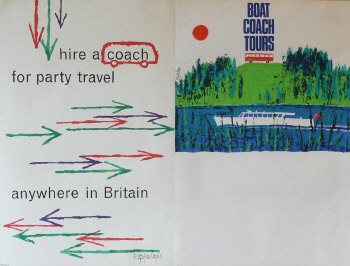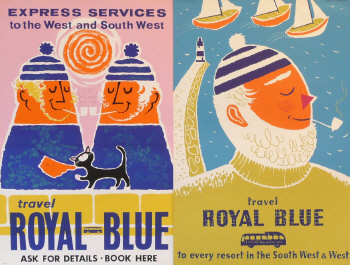I can’t resist a few instant observations about Morphets. The full set of opinions will have to wait until I’ve got the complete results in front of me and some more time, but for the moment, we’ll deal with what I know.
Firstly, it’s clear that not many people like Daphne Padden and Royston Cooper as much as we do.
This is both a good thing and a bad thing. It does mean that we can pick up some lovely posters for rather less than we thought we’d have to pay – the lot above went for just £85. How anyone can not like that right hand poster in particular is beyond me. I particularly love it because the woman looks like all of my aunts in old photographs, but that’s incidental, it’s wonderful anyway.
But it also means that their work still isn’t getting the acclaim and recognition that they both deserve; particularly when kitschy 1950s seaside posters were going for way more. Perhaps it will just take a bit longer for the 1960s to come into fashion properly.
A possible third explanation (which would account for more than just these prices) is that the kind of people who buy 1960s posters don’t tend to hang around at railway and coach sales in Harrogate. Which is their loss. The left hand one above, incidentally, is an Eckersley which I have never seen before. Has anyone else spotted it elsewhere?
Although more likely is that there just isn’t a developed enough market in coach posters for people to be competing over them. Because 1960s London Underground posters did do well, with most of them hitting £80 – £100+, like this delectable John Burningham.
All of which adds up to the fact that I don’t really have a definite answer on Padden and Cooper values; if you have any thoughts, I’d love to hear them.
My other main observation is that auctions and their prices operate outside the world of logic, and I shall illustrate this with a small amount of mathematics.
This pair of posters went for £80.
If we say that the poster on the left is worth no more than £20, that values our sailor at £60. So far so good.
This pair then went for £260.
Which makes our friends with the cat worth £200-ish.
Except that, just a few lots later, this went for just £65.
Despite the fact that this version is in better condition. Unless the very subtle differences in the typography matter to people, this makes no sense at all. But I can’t think about it any more because it’s making my head ache.
More thoughts on Morphets later on this week, something completely different tomorrow.







My gosh you have an eye for a thing of beauty! Is that an expression? If not, it should be!
I know nought about auctions, much less poster auctions, but I do wonder if folks shop with an interior design perspective in mind rather than a collector’s aesthetic. For instance, those two sailor posters make a very handsome pair… perhaps more so than the other combinations on offer. Some folks don’t like to have to separate the wheat from the chaff so t’speak.
Just an uneducated guess.
I am completely in awe of / in love with the red Eckersley and the autumnal Burningham.
I never knew of these folks before so I am learning a lot from your wonderful little blog! Thank you! xo
Thank you very much – and I do enjoy sharing them with other people.
You’re probably right about the sailors; they do make much more sense as a pair, it’s just that I would never pay twice as much for them that way round.
I ought to write about John Burningham one of these days; he did some really beautiful designs for LT in the 60s and then, like so many others, moved into children’s books – and we read his books to our daughter now, which is very satisfying.
I’ve just found your wondeful blog after discovering the notting hill gate hidden posters on flickr which feature the Daphne Padden sailor poster – a particular favourite! thanks for sharing these coach posters which I haven’t come across before, truly inspiring!
I’m really glad you’re enjoying them! It’s such a shame that they aren’t as well known as the work of some other designers.
Maybe the cat made £260 because two people fought over it and were both prepared to pay that much.
The underbidder then had no competition at all for the second cat so needed to pay no more than £65.
Yes, there’s probably quite a lot of truth in that. And the last lot was at the end of a very long sale, when all sorts of things went for less than they usually would, because people had quite simply had enough. And spent enough too.
I’d quite like the Morphets sale to come back again; with hindsight we’d spend more than we did as there were some real bargains there.